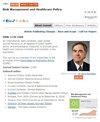Mitigating Social Isolation Among Peritoneal Dialysis Patients: The Impact of Educational Level, Physical Activity, and Familial Support
IF 2.7
4区 医学
Q2 HEALTH CARE SCIENCES & SERVICES
引用次数: 0
Abstract
Objective: This study investigates the prevalence and determinants of social isolation in peritoneal dialysis (PD) patients, focusing on the influence of environmental systems and individual behaviors on their social well-being.Methods: We conducted a cross-sectional study from December 2023 to February 2024 at Shenzhen Traditional Chinese Medicine Hospital. A total of 259 PD patients were enrolled using a consecutive sampling method. Data were collected via validated tools including the Pittsburgh Sleep Quality Index (PSQI), Lubben Social Network Scale-6 (LSNS-6), Family APGAR Questionnaire, and Social Anxiety Subscale of Self-Consciousness Scale (SASS-CS). Statistical analyses utilized Spearman correlation and multiple linear regression to identify factors associated with social isolation.
Results: The average score for social isolation was 11 (range 7– 15). Significant predictors of social isolation included education level, physical inactivity, and normal hemoglobin concentrations. Social isolation was negatively correlated with family functionality and positively correlated with social anxiety. Regression analysis confirmed education, family functionality, and social anxiety as significant independent predictors of social isolation.
Conclusion: Social isolation is common among PD patients, driven by factors such as education level, physical inactivity, and unexpectedly, normal hemoglobin levels linked to greater family isolation. Targeted interventions like education, physical activity promotion, and innovative therapies such as animal-assisted activities and social gardening can help reduce isolation and improve patient well-being.
Plain Language Summary: 1. Why is this study needed? Peritoneal dialysis is a common treatment for severe kidney disease. This study is crucial because it examines how being isolated affects patients undergoing this treatment, as social isolation can worsen their health outcomes.
2. What is the key problem/issue/question this manuscript addresses? The main issue addressed is understanding the factors that contribute to social isolation in peritoneal dialysis patients and how this isolation impacts their health and quality of life.
3. What is the main point of your study? The study explores how various factors such as education levels, physical activity, and family support influence social isolation among these patients. It also looks at the broader environmental and social settings that affect their interactions and mental health.
4. What are your main results and what do they mean? Our findings show that patients with higher education, better family support, and more physical activity are less socially isolated. Addressing these factors can greatly enhance the well-being and social interactions of peritoneal dialysis patients, suggesting the need for targeted support and community integration initiatives.
Keywords: peritoneal dialysis, social isolation, social support systems, physical inactivity, educational disparities, mental health
减轻腹膜透析患者的社会隔离:教育水平、体育活动和家庭支持的影响
目的:本研究调查了腹膜透析(PD)患者社会隔离的发生率和决定因素:本研究探讨腹膜透析(PD)患者社会隔离的发生率和决定因素,重点关注环境系统和个人行为对其社会幸福感的影响:我们于 2023 年 12 月至 2024 年 2 月在深圳市中医院进行了一项横断面研究。研究采用连续抽样法,共纳入 259 名帕金森病患者。研究采用的有效工具包括匹兹堡睡眠质量指数(PSQI)、卢本社交网络量表-6(LSNS-6)、家庭APGAR问卷和自我意识社交焦虑量表(SASS-CS)。统计分析利用斯皮尔曼相关性和多元线性回归来确定与社会隔离相关的因素:社会隔离的平均得分为 11 分(范围为 7-15 分)。社会隔离的重要预测因素包括教育水平、缺乏运动和血红蛋白浓度正常。社交孤立与家庭功能呈负相关,与社交焦虑呈正相关。回归分析证实,教育、家庭功能和社交焦虑是社会孤立的重要独立预测因素:结论:社会隔离在帕金森病患者中很常见,受教育水平、缺乏体育锻炼等因素的影响,而出乎意料的是,正常的血红蛋白水平与更大的家庭隔离有关。有针对性的干预措施,如教育、促进体育锻炼以及创新疗法,如动物辅助活动和社会园艺,有助于减少孤独感并改善患者的福祉。 平实的语言摘要:1.为什么需要这项研究?腹膜透析是治疗严重肾病的常用方法。这项研究非常重要,因为它探讨了孤独感对接受这种治疗的患者有何影响,因为社交孤独会使患者的健康状况恶化。2.2. 本手稿解决的关键问题是什么?本手稿解决的主要问题是了解导致腹膜透析患者社会隔离的因素,以及这种隔离如何影响他们的健康和生活质量。3.您的研究的重点是什么?本研究探讨了教育水平、体育锻炼和家庭支持等各种因素如何影响这些患者的社会隔离。研究还探讨了影响他们的互动和心理健康的更广泛的环境和社会背景。4.您的主要研究结果是什么?我们的研究结果表明,教育程度较高、家庭支持较好和体育锻炼较多的患者的社会隔离程度较低。解决这些因素可以大大提高腹膜透析患者的幸福感和社会交往能力,这表明有必要采取有针对性的支持和社区融合措施。
本文章由计算机程序翻译,如有差异,请以英文原文为准。
求助全文
约1分钟内获得全文
求助全文
来源期刊

Risk Management and Healthcare Policy
Medicine-Public Health, Environmental and Occupational Health
CiteScore
6.20
自引率
2.90%
发文量
242
审稿时长
16 weeks
期刊介绍:
Risk Management and Healthcare Policy is an international, peer-reviewed, open access journal focusing on all aspects of public health, policy and preventative measures to promote good health and improve morbidity and mortality in the population. Specific topics covered in the journal include:
Public and community health
Policy and law
Preventative and predictive healthcare
Risk and hazard management
Epidemiology, detection and screening
Lifestyle and diet modification
Vaccination and disease transmission/modification programs
Health and safety and occupational health
Healthcare services provision
Health literacy and education
Advertising and promotion of health issues
Health economic evaluations and resource management
Risk Management and Healthcare Policy focuses on human interventional and observational research. The journal welcomes submitted papers covering original research, clinical and epidemiological studies, reviews and evaluations, guidelines, expert opinion and commentary, and extended reports. Case reports will only be considered if they make a valuable and original contribution to the literature. The journal does not accept study protocols, animal-based or cell line-based studies.
 求助内容:
求助内容: 应助结果提醒方式:
应助结果提醒方式:


